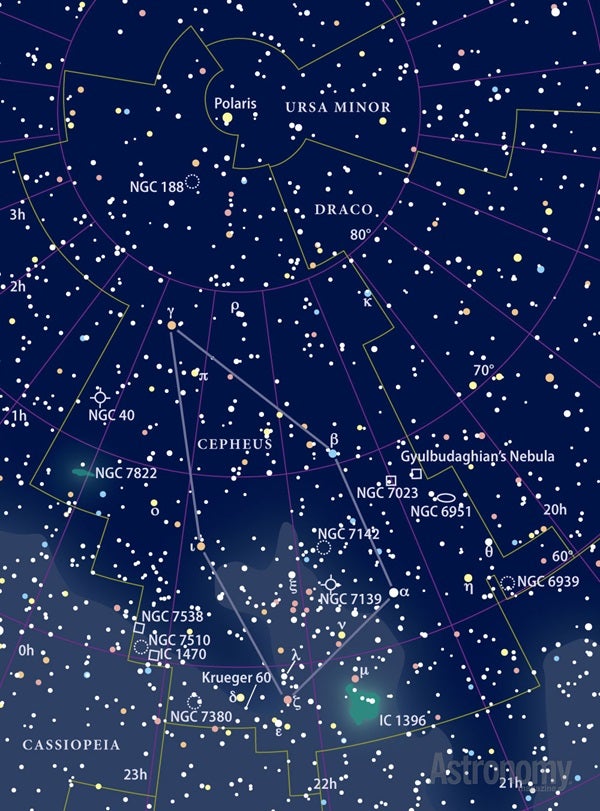Targets for September 3–10, 2015
Small telescope:
A trio of open clusters in Cygnus
Large telescope:
Planetary nebula NGC 7139
Large telescope:
Elliptical galaxy NGC 7103
The three amigos
This week’s small-telescope targets are a trio of open clusters in the constellation Cygnus the Swan: NGC 7062, NGC 7063, and NGC 7082.
Let’s start with NGC 7062. It lies 2° west-northwest of magnitude 4.0 Rho (ρ) Cygni. It’s reasonably bright at magnitude 8.3, and its small size — 5′ across — makes it easy to spot.
Through a 4-inch telescope, you’ll spot two dozen stars scattered in a rough crescent shape. Larger scopes don’t really reveal many more stars.
To find the next cluster, NGC 7063, look 2.5° southeast of magnitude 3.7 Tau (τ) Cygni. This is a scattered cluster through any size telescope, with the northern side appearing richer than the southern side. At magnitude 7.0, it’s brighter than NGC 7062, but its diameter, 9′, is almost twice as large.
A 4-inch scope reveals about 15 stars. The brightest, magnitude 8.9 HIP 105673, sits at the cluster’s southern edge.
One more of the trio to go. NGC 7082 lies 1.7° north-northwest of magnitude 4.0 Rho Cygni. It shines at magnitude 7.2 and measures a healthy 24′ across. That means it covers an area about 60 percent as large as the Full Moon.
When you first look at NGC 7082, you might think, “Oh, what a rich cluster!” Not really. Here’s a good example of a poor star cluster superimposed on a rich Milky Way background.
Through a 4-inch telescope, you’ll spot 20 or so cluster members ranging in brightness from magnitude 8 to 10. Larger apertures don’t really add many more stars.
As faint as Pluto
This week’s first large-scope object is planetary nebula NGC 7139 in Cepheus the King. You’ll find it 2° west-southwest of magnitude 4.3 Kurhah (Xi [ξ] Cephei).
In my opinion, this target requires at least a 12-inch telescope, although a few top-notch observers have viewed it through scopes with apertures as small as 8 inches. It glows softly at magnitude 13.3 and measures 78″ across.
At magnifications above 250x, NGC 7139’s disk appears circular with a diffuse edge. And here’s a tip: Use an Oxygen-III filter when you observe this planetary because it will dim the surrounding stars.
Slightly southern galaxies
This week’s second large-telescope target is elliptical galaxy NGC 7103 in the zodiacal constellation Capricornus. It’s actually part of a small group of galaxies that lies 3° east of magnitude 3.7 Zeta (ζ) Capricorni. The brightest — and at magnitude 12.6, that’s not saying much — is NGC 7103.
You’ll need at least a 14-inch or larger telescope and a magnification of 250x. Using that power, you’ll see NGC 7103 as slightly oval (it measures 1.4′ by 1.2′) with a brighter central region. Magnitude 13.8 NGC 7104 lies 4′ to the northeast, and magnitude 14.8 IC 5122 lies 4′ to the north-northwest.
Expand your observing at Astronomy.com
StarDome
Check out Astronomy.com’s interactive StarDome to see an accurate map of your sky. This tool will help you locate this week’s targets.
The Sky this Week
Get a daily digest of celestial events coming soon to a sky near you.
Observing Basics
Find more guidance from Senior Editor Michael E. Bakich with his Observing Basics video series.











